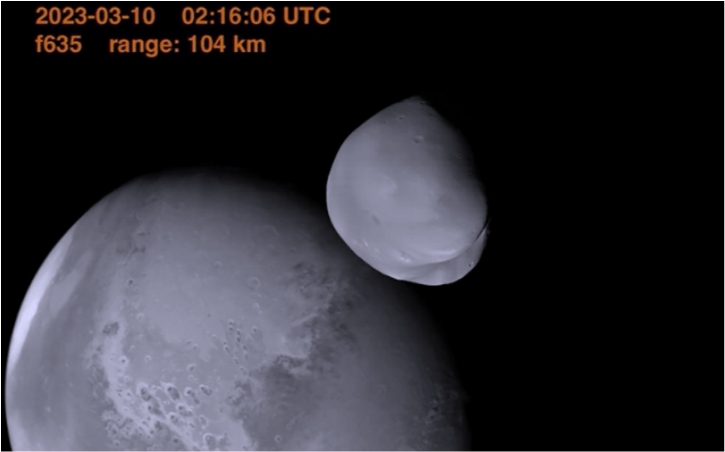
The United Arab Emirates’ Amal spacecraft has captured detailed photos of Mars’ little moon, Deimos, and its far side. This marks the closest a spacecraft has come to Deimos in almost half a century. The images were released on Monday and also included photobombs by Mars.
Deimos is an odd-shaped, cratered moon that measures just 9 miles by 7 miles by 7 miles in size. It is significantly smaller than Mars’ other moon, Phobos, which is almost double its size and orbits much closer to Mars. The UAE Space Agency’s lead scientist, Hessa al-Matroushi, and her team analyzed the new images and concluded that Deimos may be of Martian origin, which challenges the leading theory that it is an asteroid captured in Mars’ orbit eons ago. These findings were presented at the European Geosciences Union’s general assembly in Vienna on Monday.
Amal’s mission is to better understand the Martian atmosphere and climate. The spacecraft is orbiting Mars and flew within 62 miles of Deimos last month. The mission’s goal is to provide detailed and comprehensive data on the planet.
The Amal spacecraft was launched as part of the UAE’s mission to advance its space exploration capabilities and develop a knowledge-based economy. It was the first Arab interplanetary mission and the first time a Mars mission was led by a team of women. The mission’s scientific goals include studying the Martian atmosphere, climate, and weather patterns. Amal carries three scientific instruments designed to provide a global view of the Martian atmosphere and measure the interaction between the lower and upper atmosphere.
The spacecraft also carries a high-resolution camera that has captured stunning images of the Martian landscape and has helped scientists better understand the planet’s geology. The images have revealed evidence of ancient rivers, lakes, and even oceans that may have existed on Mars billions of years ago, indicating that the planet may have had the right conditions to support life at some point in its history.
The UAE’s space program is still in its early stages, but it has ambitious plans for the future. The country aims to establish a human settlement on Mars by 2117, and it has already started training its first batch of Emirati astronauts. The country is also working on other space projects, including a lunar rover that it plans to send to the Moon in 2024.
The UAE’s space ambitions have not gone unnoticed by other countries, and the Amal mission has attracted global attention. The mission has been praised for its scientific achievements, as well as for the role it has played in promoting science and technology in the region.
In addition to the scientific goals, the Amal mission also has broader geopolitical implications. The UAE sees its space program as a way to enhance its national security and expand its influence in the region. It has also used the mission as a way to showcase its technological capabilities and project a more modern and progressive image to the world.
The UAE’s space program has come a long way in a short time, and it is clear that the country has big ambitions for the future. The success of the Amal mission is a testament to the country’s growing expertise in space exploration and its determination to play a leading role in the global space community. As the UAE continues to invest in its space program, it is likely to emerge as a major player in the space race in the years to come.
